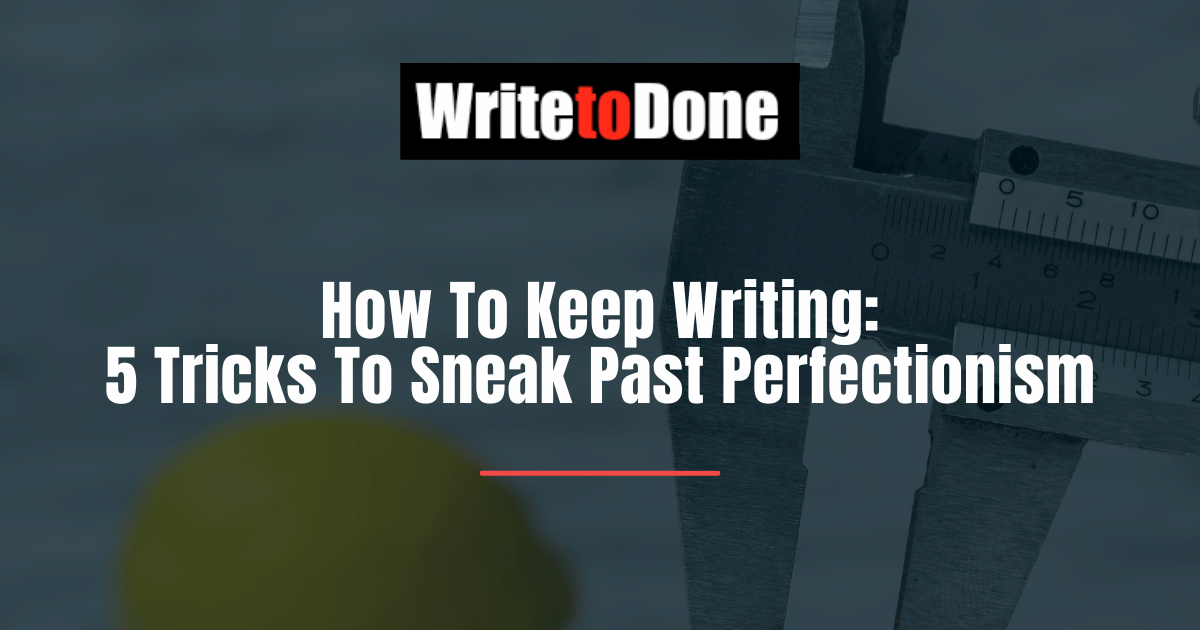Have you been sitting in front of your computer for what feels like hours?
You know the feeling.
Typing a few words, deleting them, groaning in frustration, getting a couple of sentences down only to decide they’re not quite right…
You’re about ready to tear your hair out.
You recognize what’s happening, of course. Your inner perfectionist is rearing its obnoxious head, inciting an epic battle between you and the blank page.
And the blank page is winning.
This could happen for several reasons.
Maybe you’ve got a deadline looming and you’re under time pressure.
Maybe you only have a rough idea of what you want to write about, and you’re worried it’s not going to come out coherently.
Or maybe you care so much about your subject matter that you’re afraid you’ll never do it justice.
Whatever the cause, you’re stuck. Of course you’ve heard all the well-meaning advice about not being a perfectionist; to just get something written that you can edit later.
But you honestly can’t write just anything.
Wondering how to keep writing?
Don’t despair. Here are five ways to approach the writing process that you might not have considered. They just may help you break out of the impasse you’re in.
Tip #1: Bite the Bullet(s)
You may be intimidated at the thought that you need to turn out paragraph after paragraph of perfectly praiseworthy prose.
Don’t worry about that. Instead, jot down your main ideas as a set of bullet points. Pretend someone has asked you for a 30-second synopsis of your article, post or story. What would you tell them—quickly?
Once you’ve got those points down, add a brief sentence or two to further describe or explain each one. Nothing fancy—keep it simple. They don’t even need to be complete sentences.
At this point I’d advise walking away and taking a break for a while, even if it’s only for 10-15 minutes. When you come back, you’ll be mentally fresh. Now review what you’ve written and see where you can elaborate on your points a little further.
Again, you don’t need to write complete sentences. Don’t even worry about connecting your ideas. Just get your thoughts down in rough form.
Before you know it, you’ll have a decent framework for your piece of writing.
Sure, you’ll need to go back and fill in the gaps to turn that cursory outline into something more substantial.
But you’ve broken through your deadlock. You now have some actual material to work with. And it’s much easier to add to something that exists than to start from scratch, which was the problem you had earlier.
Tip #2: Confide in Yourself
Another way to do an end-run around your inner perfectionist is to write your piece as a journal or diary entry. When you’re writing to yourself, no one will see it, so you don’t have to care how it sounds.
Let it all pour out. Go for stream-of-consciousness writing… keep your fingers moving on the keyboard, and don’t stop.
It doesn’t matter if you come up with clunky or disconnected sentences.
In fact, you will.
But you’ll also produce others that will say, clearly and concisely, exactly what you mean.
For now, just keep writing. Later you can go digging for the gold in the mass of words you’ve assembled.
That’s when you can finally admit that other people will be reading this.
But by then it won’t matter because once again, it’s much easier to tweak material that exists.
Tip #3: E-mail a Friend
Ever notice how some of your best writing happens when you’re composing casual e-mails (or even long text messages) to your buddies?
It’s no accident. When you know you don’t need to stand on ceremony, you don’t worry about making everything perfect. You express yourself simply, and the words flow.
So take advantage of this fact. Imagine you’re writing to your best friend.
If you’re reporting on something, tell it like a fascinating story. If you’re trying to make a series of points or arguments, do your best to persuade your pal in a friendly way.
The key is to pretend honestly. Behave as though you really are writing to your friend—include jokes, personal anecdotes, and whatever you would write if you were really e-mailing them.
You can always take out this material later when you edit—but you may be surprised to find out how much of it you decide to keep.
This is another great technique for getting something substantial written down when you’re feeling stuck, because it’s so easy to communicate with a friend.
And once you’ve got your “e-mail” composed, you can edit it for your actual readers.
Tip #4: Try Longhand
If you can’t make anything happen on your screen, try paper instead.
That’s right, I’m talking about good, old-fashioned handwriting.
You may be inclined to dismiss this tip because it feels like too much work, but give it a try and you might well be surprised how effective it is.
That’s because writing by hand engages your brain in a different way than typing does. A 2014 New York Times article cites a study that compared printing, cursive writing, and typing in young schoolchildren. According to the article, “When the children composed text by hand, they not only consistently produced more words more quickly than they did on a keyboard, but expressed more ideas.”
Not only that, there are two other ways in which this tip works to combat perfectionism. First, if you scrawl messily in a cheap spiral notebook or on a legal pad, you can convince yourself that “it’s not all that important anyway.” That way you won’t get so hung up on the need to make the first draft flawless.
Second, you’ll eventually need to type out your writing. When you do, edits will spontaneously suggest themselves, and you’ll be improving your writing even as you type it out, effortlessly creating a second draft.
Finally, there’s the added advantage that you can toss your notebook or pad in whatever bag you normally carry around with you, and get some writing done in places where you might normally not. The change of scenery alone can stimulate your creativity.
Not bad for an “old-fashioned” method of writing, huh?
Tip #5: Be a Dictator
Let’s face it—sometimes it’s much easier to talk about something than to write about it. So if you’re feeling stuck, why not dictate instead of typing?
The do-it-yourself way to go about this is with dictation software. The gold standard is Dragon Naturally Speaking by Nuance. This does cost some money. It also takes time and effort to learn to use the program and train it to interpret your voice more accurately over time. However, it’s well worth it in the long run if you decide you like “speaking your writing.”
But if you just want to give dictation a try to see if it works for you, you’re better off using the voice recorder on your smartphone (or purchasing an inexpensive digital voice recorder), uploading the sound file, and hiring someone to transcribe what you record. You can find transcriptionists on Upwork, Fiverr, and many other places online (though be sure to do your research and make certain you’re hiring someone reputable).
You can even combine this with tip #3 above and pretend you’re chatting with a friend. Don’t worry about the finished transcript sounding too casual—you’re going to review it when it comes back from the transcriptionist (or your software) anyway, and you can edit out anything that you don’t want in the finished piece.
Reaching Momentum
As a writer, there’s nothing worse than the feeling of being completely unable to write.
This usually happens because we feel intimidated, thinking we must produce amazing results the instant we set our hands on the keyboard.
Once we break this paralysis and get some actual writing done, it’s much easier to keep the momentum going. But getting to that point can be a challenge.
These tips on how to keep writing can help you get there.
So pick whichever tip resonates the most with you, and give it a try.
Sooner than you can say “I’m nixing perfectionism,” you’ll be poring over the pages of writing you’ve generated, and editing them into a final form that will bring your ideas out into the public eye.
Where they deserve to be.
What do you do to nix perfectionism? Write your tips in the comments, and please share this post on social media if you liked it!
















